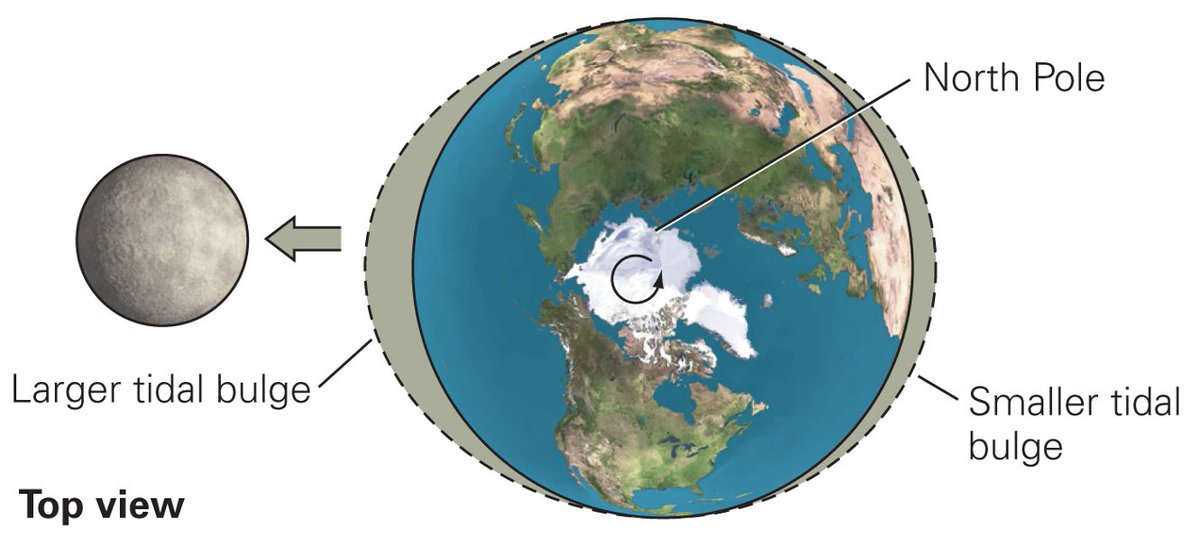The asymmetry in the height of daily tides is not due to being "under" the Moon versus "opposed" to it. In fact, half the time, the reverse is true! 2/n
One can de-bunk the idea that the tide facing the Moon is always larger by just looking at the tides for a shoreline just about anywhere on Earth. I picked Chincoteague, VA. 3/n
Currently, the Moon is full so it is highest in the sky near one of the daily high tides but corresponding to the lower high tide each day. The higher high tide occurs when the Moon is on the opposite side of Earth(!) contrary to the figure and the explanation in the text. 4/n
Around the neap tides on 12/9, the tidal system switches and the higher high tide is associated with the Moon being overhead and the lower high tide with the Moon being on the opposite side of Earth. It switches back at the next neap tide. 5/n
What is really going on?
The pattern of maxima and minima overprinted on the regular sinusoidal tidal signal are called envelope functions, and these are due to a slower period signal. Namely, a monthly as opposed to a daily signal. 6/n
The pattern of maxima and minima overprinted on the regular sinusoidal tidal signal are called envelope functions, and these are due to a slower period signal. Namely, a monthly as opposed to a daily signal. 6/n
The orientation of the Earth-Moon changing relative to the Sun is responsible for the spring and neap tide signal-the overall growing and shrinking of tidal heights as the Earth and Moon go into and out of alignment with the Sun. Spring when aligned in a row and neap when not.7/n
A more subtle monthly signal is responsible for the asymmetry between daily tidal heights that started this twitter thread and that textbooks routinely get wrong.
What is it? The lunar inclination! 8/n
What is it? The lunar inclination! 8/n
The lunar what?!?
The Earth-Moon orbit is not aligned with the equator of Earth. We call the angular measure of this misalignment the lunar inclination, and it's about 5 deg. 9/n
The Earth-Moon orbit is not aligned with the equator of Earth. We call the angular measure of this misalignment the lunar inclination, and it's about 5 deg. 9/n
This means that for about half of the Moon's orbit, it's above Earth's equator and for half of the Moon's orbit, it's below. 10/n
When the Moon is above Earth's equator, the max tidal bulge on the side of Earth facing the Moon is also above Earth's equator. The max tidal bulge on the opposite side of Earth from the Moon is then below the equator. 11/n
The max tidal bulges are the same amplitude but circling Earth at different latitudes. This is why a shoreline, which is at a constant latitude, experiences different height high tides each day. Which one is higher changes as the Moon goes through its inclined (tilted) orbit.12/n
This is a lot for an introductory textbook that only spends one chapter on oceanography to explain, so I don't expect books like this to do so, but I do expect books to at least follow some version of Hippocrates' Oath and commit to doing no harm. 13/n
This is a great short accurate explanation of tides for further reading ( https://www.lockhaven.edu/~dsimanek/scenario/tides101.htm), and it comes with a lot more content if you want to dig deep including other common tidal misconceptions ( https://www.lockhaven.edu/~dsimanek/scenario/tides.htm) 14/14
This was a late night twitter thread written out of angst with what otherwise is a great undergraduate textbook, so I skipped explaining the basics of tides but I feel I owe that explanation to the reader so here it is: https://twitter.com/sethajacobson/status/1334533099368161283?s=20

 Read on Twitter
Read on Twitter



